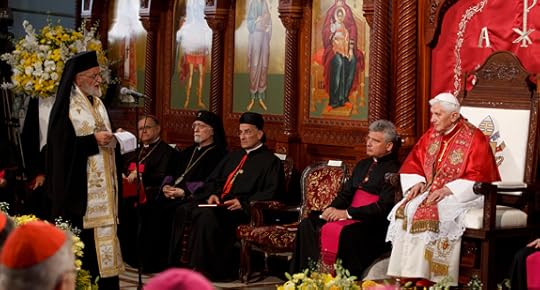Unity of Faith in a Diversity of Traditions

Unity of Faith in a Diversity of Traditions | Christopher B. Warner | Catholic World Report
Pope Benedict XVI’s plan for enriching cooperation among the Churches of the Middle East
It was
impossible not to notice the colorful, varied display of liturgical vestments
and clerical garb during the recent papal visit to Lebanon. The rich cultural
diversity among Christians in the Middle East gives witness to the Apostolic
traditions which began to develop almost immediately and independently from
each other at the very beginning of Christianity. As the Apostles spread the
gospel and worship of Jesus Christ to the far corners of the known world,
distinct liturgical traditions naturally burgeoned as local churches took root.
The six
liturgical traditions of the Catholic Church were conspicuously present by the
end of the fourth century and are still celebrated in Lebanon and throughout
the Middle East today: the Liturgy of St. Mark (Coptic and Ethiopian), the
Liturgies of Sts. John Chrysostom and Basil (Greek Melkite), the Liturgy of St.
James (Maronite, Syrian, and Syro-Malankara), the East Syrian Liturgy (Chaldean
and Syro-Malabar), the Armenian Liturgy, and the Latin Mass.
Pope Benedict
XVI strongly affirmed this diversity of traditions as a harmony within the unity
of faith in his post-synodal apostolic exhortation “The Church in the Middle East,”
which was signed and distributed to the major hierarchs during his recent visit
to Lebanon:
Like my Predecessors in the
See of Peter, I wish here to state once more my desire to ensure that the rites
of the Eastern Churches, as the patrimony of the whole Church of Christ in which
shines forth the tradition coming down from the Apostles through the Fathers,
and which, in its variety, affirms the divine unity of the Catholic faith, are
observed and promoted conscientiously.
Pope Benedict dedicated a large portion of
this exhortation to urging the different Churches to pray, learn, and work
together in order to promotes true communion among Christians and true peace,
which he defined as “the state of those who live in harmony with God and with
themselves, with others and with nature.” He invited the Catholics of the
various ecclesial communities to foster relationships with each other and to be
mutually engaged in one another’s traditions.
Carl E. Olson's Blog
- Carl E. Olson's profile
- 20 followers



